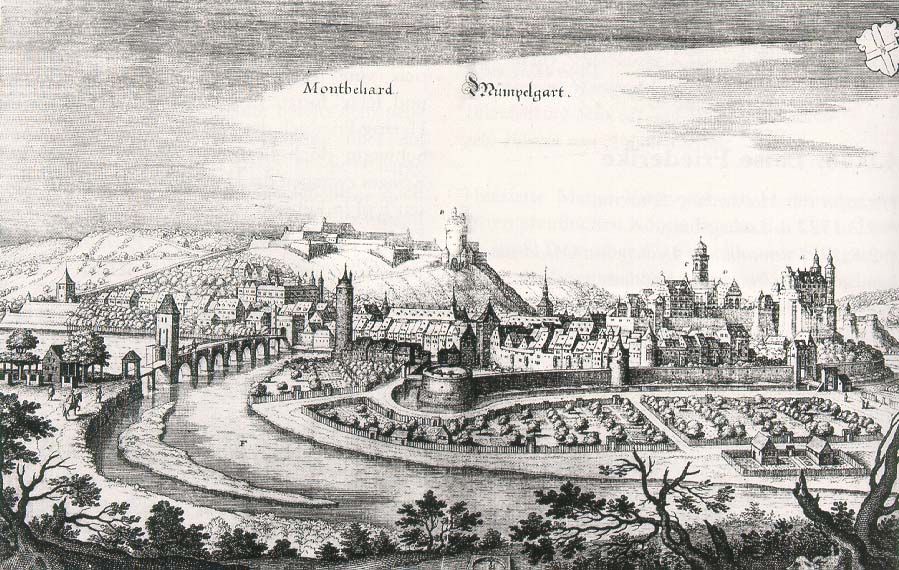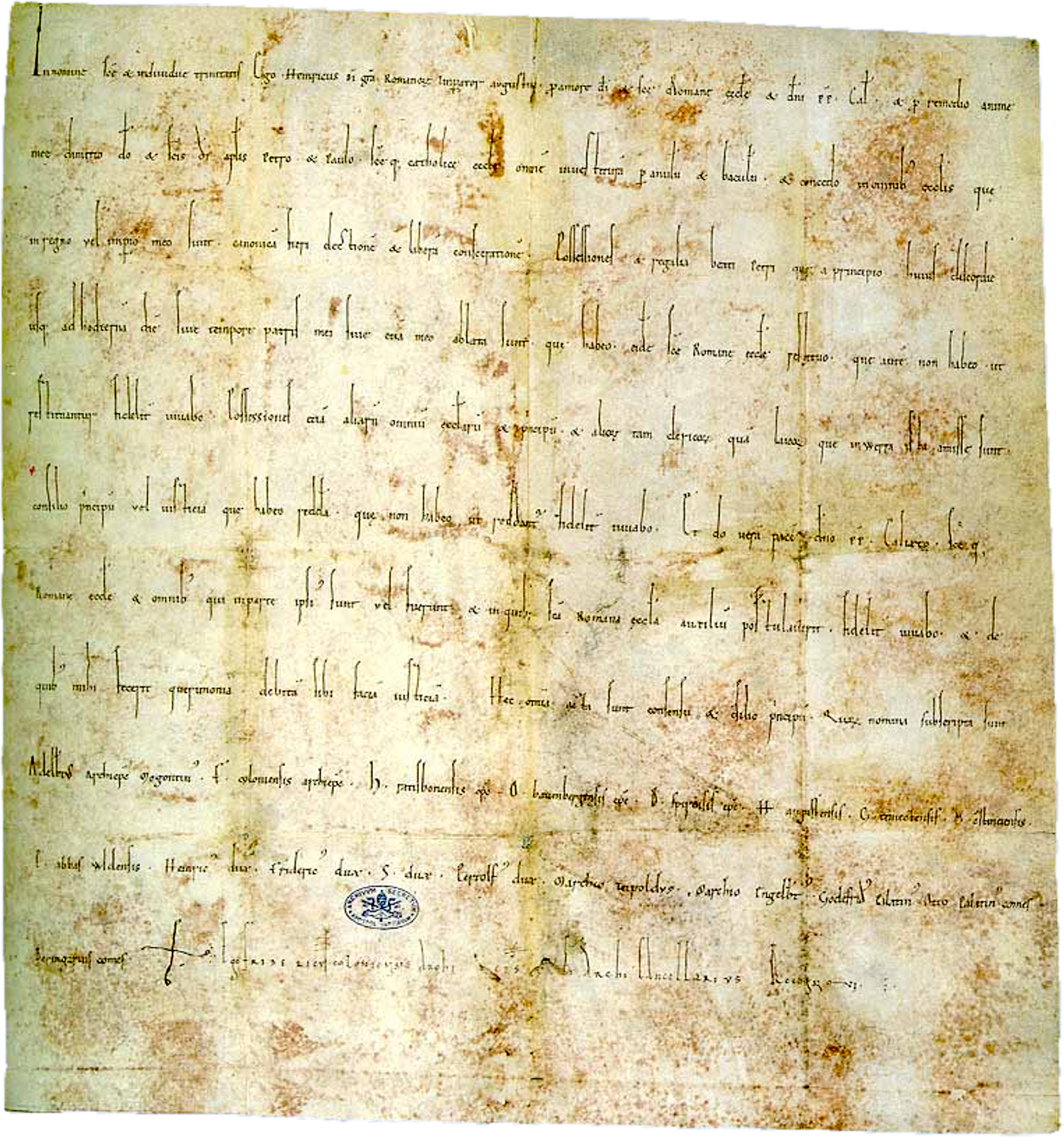|
Theodoric II, Count Of Montbéliard
Theodoric II (ca. 1080 – January 1163) was Count of Montbéliard (1105–1163). He was the son of Theodoric I, Count of Montbéliard, Bar and Verdun, and Ermentrude of Burgundy. He received first possessions of the family, but they were chased by his subjects because of his bad temper. After the death of his father in 1105, he received the county of Montbéliard, becoming its count that same year. He played an important role with emperors, participating in the Concordat of Worms. He had also founded several monasteries. His wife is unknown. He had the following issue: *Theodoric III, who died between 1155 and 1160. Married to Gertrude Habsburg, the daughter of Werner II, Count of Habsburg *Sophie († 1148), married in 1128 to Richard II, Count of Montfaucon. It was their son, Amadeus II of Montfaucon, who succeeded his grandfather. *Stephanie, married to Folmar, Count of Sarrewerden *Ermentrude, married to Eudes, Count of la Roche {{DEFAULTSORT:Theodoric Ii, Count Of ... [...More Info...] [...Related Items...] OR: [Wikipedia] [Google] [Baidu] |
Count Of Montbéliard
Count (feminine: countess) is a historical title of nobility in certain European countries, varying in relative status, generally of middling rank in the hierarchy of nobility. Pine, L. G. ''Titles: How the King Became His Majesty''. New York: Barnes & Noble, 1992. p. 73. . The etymologically related English term "county" denoted the territories associated with the countship. Definition The word ''count'' came into English from the French ''comte'', itself from Latin ''comes''—in its accusative ''comitem''—meaning “companion”, and later “companion of the emperor, delegate of the emperor”. The adjective form of the word is "comital". The British and Irish equivalent is an earl (whose wife is a "countess", for lack of an English term). In the late Roman Empire, the Latin title ''comes'' denoted the high rank of various courtiers and provincial officials, either military or administrative: before Anthemius became emperor in the West in 467, he was a military ''comes ... [...More Info...] [...Related Items...] OR: [Wikipedia] [Google] [Baidu] |
Theodoric II Of Bar
Theodoric is a Germanic given name. First attested as a Gothic name in the 5th century, it became widespread in the Germanic-speaking world, not least due to its most famous bearer, Theodoric the Great, king of the Ostrogoths. Overview The name was Latinized as ''Theodoricus'' or ''Theodericus'', originally from a Common Germanic form ''* Þeudarīks'' ("people-ruler") from *'' þeudō'' ("people") and *''rīks'', which would have resulted in a Gothic *𐌸𐌹𐌿𐌳𐌰𐍂𐌴𐌹𐌺𐍃 (*þiudareiks). Anglicized spellings of the name during Late Antiquity and the Early Middle Ages include ''Theodoric'', ''Theoderic'', ''Theudoric'', ''Theuderic''. Gregory of Tours Latinized the name as '' Theodorus'', in origin the unrelated Greek name Theodore (Θεόδωρος, meaning "God's gift"). As the name survived throughout the Middle Ages, it transformed into a multitude of forms in the languages of Western Europe. These include the High German form '' Dietrich'', abbrev ... [...More Info...] [...Related Items...] OR: [Wikipedia] [Google] [Baidu] |
Counts And Dukes Of Bar
The County of Bar, later Duchy of Bar, was a principality of the Holy Roman Empire encompassing the '' pays de Barrois'' and centred on the city of Bar-le-Duc. It was held by the House of Montbéliard from the 11th century. Part of the county, the so-called ''Barrois mouvant'', became a fief of the Kingdom of France in 1301 and was elevated to a duchy in 1354. The ''Barrois non-mouvant'' remained a part of the Empire. From 1480, it was united to the imperial Duchy of Lorraine. Both imperial Bar and Lorraine came under the influence of France in 1735, with Bar ceded to the deposed king of Poland, Stanisław Leszczyński. According to the Treaty of Vienna (1738), the duchy would pass to the French crown upon Stanisław's death, which occurred in 1766. County (1033–1354) The county of Bar originated in the frontier fortress of Bar (from Latin ''barra'', barrier) that Duke Frederick I of Upper Lorraine built on the bank of the river Ornain around 960. The fortress was originally ... [...More Info...] [...Related Items...] OR: [Wikipedia] [Google] [Baidu] |
Counts Of Verdun
The County of Verdun was a sovereign medieval county in the Duchy of Lower Lorraine. County The rulers of the sovereign County of Verdun styled themselves as Counts by the grace of God. country was located near Lower Lotharingia within the . The bordered on it from the east. The formed the western border of the county, but it also included the fortresses at ... [...More Info...] [...Related Items...] OR: [Wikipedia] [Google] [Baidu] |
Montbéliard
Montbéliard (; traditional ) is a town in the Doubs Departments of France, department in the Bourgogne-Franche-Comté Regions of France, region in eastern France, about from the border with Switzerland. It is one of the two Subprefectures in France, subprefectures of the department. History Montbéliard is mentioned as early as 983 as . The County of Montbéliard or Mömpelgard was a feudal Graf, county of the Holy Roman Empire from 1033 to 1796. In 1283, it was granted rights under charter by Count Reginald of Burgundy, Reginald. Its charter guaranteed the county perpetual liberties and franchises which lasted until the French Revolution in 1789. Montbéliard's original municipal institutions included the Magistracy of the Nine Bourgeois, the Corp of the Eighteen and the Notables, a Mayor, and Procurator, and appointed "Chazes", all who participated in the administration of the county as provided by the charter. Also under the 1283 charter, the Count and the people of Montb ... [...More Info...] [...Related Items...] OR: [Wikipedia] [Google] [Baidu] |
Concordat Of Worms
The Concordat of Worms(; ) was an agreement between the Catholic Church and the Holy Roman Empire which regulated the procedure for the appointment of bishops and abbots in the Empire. Signed on 23 September 1122 in the German city of Worms by Pope Callixtus II and Emperor Henry V, the agreement set an end to the Investiture Controversy, a conflict between state and church over the right to appoint religious office holders that had begun in the middle of the 11th century. By signing the concordat, Henry renounced his right to invest bishops and abbots with ring and crosier, and opened ecclesiastical appointments in his realm to canonical elections. Callixtus, in turn, agreed to the presence of the emperor or his officials at the elections and granted the emperor the right to intervene in the case of disputed outcomes. The emperor was also allowed to perform a separate ceremony in which he would invest bishops and abbots with a sceptre, representing the imperial lands associated w ... [...More Info...] [...Related Items...] OR: [Wikipedia] [Google] [Baidu] |
Werner II, Count Of Habsburg
Werner II of Habsburg (died 19 August 1167) was Count of Habsburg also called Werner III and a progenitor of the royal House of Habsburg. He was the great-great-grandfather of King Rudolph I of Germany. He was the son of Count Otto II of Habsburg and Hilla of Pfirt. Werner married Ida of Homberg. He is known for having been involved in the War of Bregenz Succession of 1164 – 1166. He died near Tusculum after the Battle of Monte Porzio. He was the father of Count Albert III of Habsburg and Bishop Otto II of Constance Constance may refer to: Places *Konstanz, Germany, sometimes written as Constance in English *Constance Bay, Ottawa, Canada * Constance, Kentucky * Constance, Minnesota * Constance (Portugal) * Mount Constance, Washington State People * Consta ... (1165–1174). His daughter Richenza married Count Louis I of Pfirt. References Entry at worldroots 12th-century births 1167 deaths Year of birth unknown Counts of Habsburg {{Germany-noble ... [...More Info...] [...Related Items...] OR: [Wikipedia] [Google] [Baidu] |
House Of Habsburg
The House of Habsburg (), alternatively spelled Hapsburg in Englishgerman: Haus Habsburg, ; es, Casa de Habsburgo; hu, Habsburg család, it, Casa di Asburgo, nl, Huis van Habsburg, pl, dom Habsburgów, pt, Casa de Habsburgo, la, Domus Habsburg, french: Maison des Habsbourg and also known as the House of Austriagerman: link=no, Haus Österreich, ; es, link=no, Casa de Austria; nl, Huis van Oostenrijk, pl, dom Austrii, la, Domus Austriæ, french: Maison d'Autriche; hu, Ausztria Háza; it, Casa d'Austria; pt, Casa da Áustria is one of the most prominent and important dynasties in European history. The house takes its name from Habsburg Castle, a fortress built in the 1020s in present-day Switzerland by Radbot of Klettgau, who named his fortress Habsburg. His grandson Otto II was the first to take the fortress name as his own, adding "Count of Habsburg" to his title. In 1273, Count Radbot's seventh-generation descendant Rudolph of Habsburg was elected King of the ... [...More Info...] [...Related Items...] OR: [Wikipedia] [Google] [Baidu] |
Montfaucon, Doubs
Montfaucon () is an affluent commune in the Doubs department in the region of Bourgogne-Franche-Comté, France. Geography Montfaucon lies southeast of Besançon in the valley of the Doubs. Population See also * Communes of the Doubs department The following is a list of the 571 communes of the Doubs department of France. The communes cooperate in the following intercommunalities (as of 2020):Official website Communes of Doubs {{Doubs-geo-stub ... [...More Info...] [...Related Items...] OR: [Wikipedia] [Google] [Baidu] |
Amadeus II Of Montfaucon
Amadeus II of Montfaucon (1130–1195) was Count of Montbéliard and Lord of Montfaucon from 1163 until his death. He was the son of Richard II of Montfaucon and Sophie of Montbéliard, daughter of Theodoric II, Count of Montbéliard. He was ultimately succeeded by his son Richard III of Montfaucon. He first married to Beatrice Grandson-Joinville, then Osilie of Faucogney, and had the following issue: * Walter I of Montbéliard who was Regent of the Kingdom of Cyprus (1206-1210). * Richard III who succeed his father * Agnès of Montfaucon Amadeus was a member of the House of Montfaucon, and was the Count of Montbéliard Count (feminine: countess) is a historical title of nobility in certain European countries, varying in relative status, generally of middling rank in the hierarchy of nobility. Pine, L. G. ''Titles: How the King Became His Majesty''. New York: ... from 1163 until his death in 1195. House of Montfaucon Counts of Montbéliard 1130 births 1195 d ... [...More Info...] [...Related Items...] OR: [Wikipedia] [Google] [Baidu] |
Sarrewerden
Sarrewerden (; ) is a commune in the Bas-Rhin department in Grand Est in northeastern France. The localities of ''Bischtroff-sur-Sarre'' and ''Zollingen'' are incorporated in the commune since 1972. See also * Communes of the Bas-Rhin department The following is a list of the 514 communes of the Bas-Rhin department of France. The communes cooperate in the following intercommunalities (as of 2020):Communes of Bas-Rhin Bas-Rhin communes articles needing translation from French Wikipedia {{BasRhin-geo-stub ... [...More Info...] [...Related Items...] OR: [Wikipedia] [Google] [Baidu] |
Theodoric I Of Montbéliard
Theodoric is a Germanic given name. First attested as a Gothic name in the 5th century, it became widespread in the Germanic-speaking world, not least due to its most famous bearer, Theodoric the Great, king of the Ostrogoths. Overview The name was Latinized as ''Theodoricus'' or ''Theodericus'', originally from a Common Germanic form ''* Þeudarīks'' ("people-ruler") from *'' þeudō'' ("people") and *''rīks'', which would have resulted in a Gothic *𐌸𐌹𐌿𐌳𐌰𐍂𐌴𐌹𐌺𐍃 (*þiudareiks). Anglicized spellings of the name during Late Antiquity and the Early Middle Ages include ''Theodoric'', ''Theoderic'', ''Theudoric'', ''Theuderic''. Gregory of Tours Latinized the name as '' Theodorus'', in origin the unrelated Greek name Theodore (Θεόδωρος, meaning "God's gift"). As the name survived throughout the Middle Ages, it transformed into a multitude of forms in the languages of Western Europe. These include the High German form '' Dietrich'', abbrev ... [...More Info...] [...Related Items...] OR: [Wikipedia] [Google] [Baidu] |



